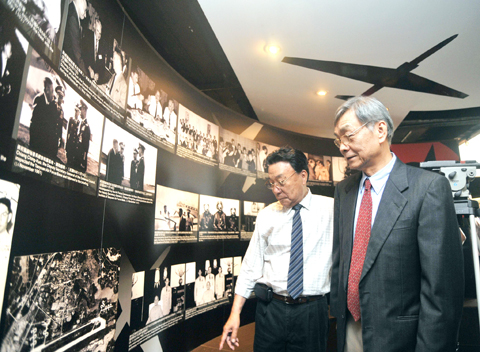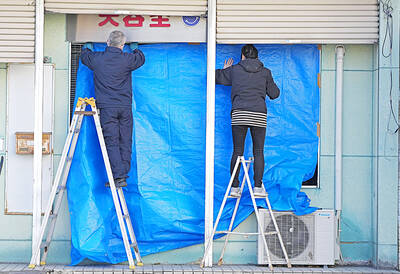For weeks after narrowly escaping two Chinese missiles, Chuang Jen-liang (莊人亮) would wake up at night bathed in sweat, but the spy pilot could talk to no one about his missions.
Only now, more than four decades later, is 73-year-old Chuang able to speak out about his harrowing experiences, as Taiwan is lifting the veil on one of its most closely guarded secrets of the Cold War.
This brings credit to Chuang and other veterans of the 35th “Black Cats” Squadron who flew at altitudes of more than 20,000m to gather intelligence about the Chinese, risking their lives each time.

PHOTO: PATRICK LIN/ AFP
“I doubt if I’d be so lucky if I had to go through all this again,” said Chuang, who now lives in an apartment in Hsinchu City.
The elite Black Cats, who were operational from 1961 until 1974, flew the legendary U-2 airplane, dubbed “Dragon Lady” and a crucial intelligence tool at the time.
That made the squadron a key element in the intelligence relationship between the US government and the Chinese Nationalist Party (KMT) government.
“The information they gathered was crucial for understanding the Chinese communists’ military deployment, especially since spy satellites weren’t available,” Air Force Lieutenant General Wang Mu-jung (王木榮) said.
However the information came at a steep cost. At the height of the Cold War, flying the U-2 was one of the most dangerous jobs any military man could perform.
Of the 28-member Black Cat squadron, four were shot down and killed over China, while two were taken prisoner and kept incarcerated for nearly 20 years.
Six lost their lives during training missions.
One of the Black Cats’ key areas of interest during the 1960s was China’s speedily evolving nuclear program, a source of great concern after Beijing detonated its first atomic bomb in October 1964.
Fears that China was now developing a hydrogen bomb formed the backdrop to Chuang’s most complicated and daring mission, codenamed “Tabasco,” on May 7, 1967, over a test site at Lop Nor in northwestern China.
Since the area was too far away from Taiwan, Chuang took off from a US base in northern Thailand, and once over the target zone he dropped a pair of 2m-long sensors onto the desert floor.
Six weeks later, the two sensors transmitted signals to Taipei confirming that China had tested its first hydrogen bomb.
In all their missions, the Black Cats were flying at altitudes too high for China’s Soviet-designed MiG planes, but instead they faced the lethal menace of its surface-to-air missiles.
Chiu Sung-chou (邱松州), a former Black Cat, remembered steering frantically to evade missiles fired against him in the skies over Dalian in 1973, with split-second decisions making the difference between life and death.
“If I had turned my plane either a little bit earlier or later after the missile alert went on inside my cockpit, I would have been hit,” he said.
Chiu’s sortie over Dalian was one of the last carried out by a Black Cat over China. The year after, the US terminated the program in the spirit of new detente with Beijing.
With tensions across the Taiwan Strait greatly reduced, and documents about the US-Taiwan cooperation in intelligence declassified, the public can finally learn more about the Black Cats.
Two schools in Taiwan are named after pilots who died in the line of duty, and the Ministry of National Defense is scheduled to hold a special exhibition in October to honor the pilots.
This is in recognition of their contribution not only in the field of military intelligence, but also to relations with the US.
“No doubt, the secretive missions of the Black Cat Squadron have helped promote military ties with Washington,” said Taiwanese aviation historian Clarence Fu (傅鏡平) said, who has coauthored a book on the subject. “The United States was rather reliant on Taiwan when it comes to spying on [China].”

Taiwanese were praised for their composure after a video filmed by Taiwanese tourists capturing the moment a magnitude 7.5 earthquake struck Japan’s Aomori Prefecture went viral on social media. The video shows a hotel room shaking violently amid Monday’s quake, with objects falling to the ground. Two Taiwanese began filming with their mobile phones, while two others held the sides of a TV to prevent it from falling. When the shaking stopped, the pair calmly took down the TV and laid it flat on a tatami mat, the video shows. The video also captured the group talking about the safety of their companions bathing

US climber Alex Honnold is to attempt to scale Taipei 101 without a rope and harness in a live Netflix special on Jan. 24, the streaming platform announced on Wednesday. Accounting for the time difference, the two-hour broadcast of Honnold’s climb, called Skyscraper Live, is to air on Jan. 23 in the US, Netflix said in a statement. Honnold, 40, was the first person ever to free solo climb the 900m El Capitan rock formation in Yosemite National Park — a feat that was recorded and later made into the 2018 documentary film Free Solo. Netflix previewed Skyscraper Live in October, after videos

Starting on Jan. 1, YouBike riders must have insurance to use the service, and a six-month trial of NT$5 coupons under certain conditions would be implemented to balance bike shortages, a joint statement from transportation departments across Taipei, New Taipei City and Taoyuan announced yesterday. The rental bike system operator said that coupons would be offered to riders to rent bikes from full stations, for riders who take out an electric-assisted bike from a full station, and for riders who return a bike to an empty station. All riders with YouBike accounts are automatically eligible for the program, and each membership account

A classified Pentagon-produced, multiyear assessment — the Overmatch brief — highlighted unreported Chinese capabilities to destroy US military assets and identified US supply chain choke points, painting a disturbing picture of waning US military might, a New York Times editorial published on Monday said. US Secretary of Defense Pete Hegseth’s comments in November last year that “we lose every time” in Pentagon-conducted war games pitting the US against China further highlighted the uncertainty about the US’ capability to intervene in the event of a Chinese invasion of Taiwan. “It shows the Pentagon’s overreliance on expensive, vulnerable weapons as adversaries field cheap, technologically